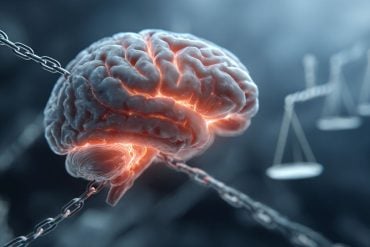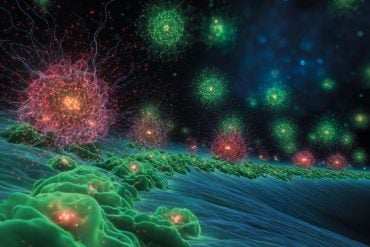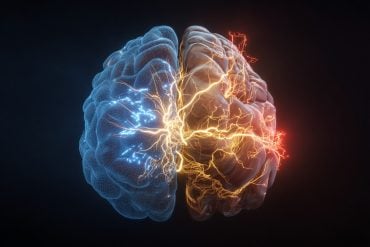Summary: Researchers have created a new math model that successfully reproduces complex brain activity during deep sleep.
Source: PLOS
New mathematical model could improve understanding of memory consolidation during deep sleep.
Researchers have built and tested a new mathematical model that successfully reproduces complex brain activity during deep sleep, according to a study published in PLOS Computational Biology.
Recent research has shown that certain patterns of neuronal activity during deep sleep may play an important role in memory consolidation. Michael Schellenberger Costa and Arne Weigenand of the University of Lübeck, Germany, and colleagues set out to build a computational model that could accurately mimic these patterns.
The researchers had previously modeled the activity of the sleeping cortex, the brain’s outer layer. However, sleep patterns thought to aid memory arise from interactions between the cortex and the thalamus, a central brain structure. The new model incorporates this thalamocortical coupling, enabling it to successfully mimic memory-related sleep patterns.
Using data from a human sleep study, the researchers confirmed that their new model accurately reproduces brain activity measured by electroencephalography (EEG) during the second and third stages of non-rapid eye movement (NREM) sleep. It also successfully predicts the EEG effects of stimulation techniques known to enhance memory consolidation during sleep.

The new model is a neural mass model, meaning that it approximates and scales up the behavior of a small group of neurons in order to describe a large number of neurons. Compared with other sleep models, many of which are based on the activity of individual neurons, this new model is relatively simple and could aid in future studies of memory consolidation.
“It is fascinating to see that a model incorporating only a few key mechanisms is sufficient to reproduce the complex brain rhythms observed during sleep,” say senior authors Thomas Martinetz and Jens Christian Claussen.
Funding: This work was supported by the grants “Plasticity and Sleep” (SFB 654) and the Graduate School “Computing in Medicine and Life Sciences” (GS-635) from the German Research Foundation and US-German Collaboration in Neuroscience (grant 01GQ1008) from the German Federal Ministry of Education and Research and the European Union Human Brain Project SP3 – Cognitive Architectures. The funders had no role in study design, data
Source: Michael Schellenberger Costa – PLOS
Image Source: NeuroscienceNews.com image is in the public domain.
Original Research: Full open access research for “A Thalamocortical Neural Mass Model of the EEG during NREM Sleep and Its Response to Auditory Stimulation” by Michael Schellenberger Costa, Arne Weigenand, Hong-Viet V. Ngo, Lisa Marshall, Jan Born, Thomas Martinetz, and Jens Christian Claussen in PLOS Computational Biology. Published online September 1 2016 doi:10.1371/journal.pcbi.1005022
[cbtabs][cbtab title=”MLA”]PLOS “Sleeping Brain’s Complex Activity Mimicked by Simple Model.” NeuroscienceNews. NeuroscienceNews, 1 September 2016.
<https://neurosciencenews.com/sleep-brain-activity-model-4948/>.[/cbtab][cbtab title=”APA”]PLOS (2016, September 1). Sleeping Brain’s Complex Activity Mimicked by Simple Model. NeuroscienceNew. Retrieved September 1, 2016 from https://neurosciencenews.com/sleep-brain-activity-model-4948/[/cbtab][cbtab title=”Chicago”]PLOS “Sleeping Brain’s Complex Activity Mimicked by Simple Model.” https://neurosciencenews.com/sleep-brain-activity-model-4948/ (accessed September 1, 2016).[/cbtab][/cbtabs]
Abstract
Fossil skulls reveal that blood flow rate to the brain increased faster than brain volume during human evolution
Few models exist that accurately reproduce the complex rhythms of the thalamocortical system that are apparent in measured scalp EEG and at the same time, are suitable for large-scale simulations of brain activity. Here, we present a neural mass model of the thalamocortical system during natural non-REM sleep, which is able to generate fast sleep spindles (12–15 Hz), slow oscillations (<1 Hz) and K-complexes, as well as their distinct temporal relations, and response to auditory stimuli. We show that with the inclusion of detailed calcium currents, the thalamic neural mass model is able to generate different firing modes, and validate the model with EEG-data from a recent sleep study in humans, where closed-loop auditory stimulation was applied. The model output relates directly to the EEG, which makes it a useful basis to develop new stimulation protocols. "A Thalamocortical Neural Mass Model of the EEG during NREM Sleep and Its Response to Auditory Stimulation” by Michael Schellenberger Costa, Arne Weigenand, Hong-Viet V. Ngo, Lisa Marshall, Jan Born, Thomas Martinetz, and Jens Christian Claussen in PLOS Computational Biology. Published online September 1 2016 doi:10.1371/journal.pcbi.1005022






